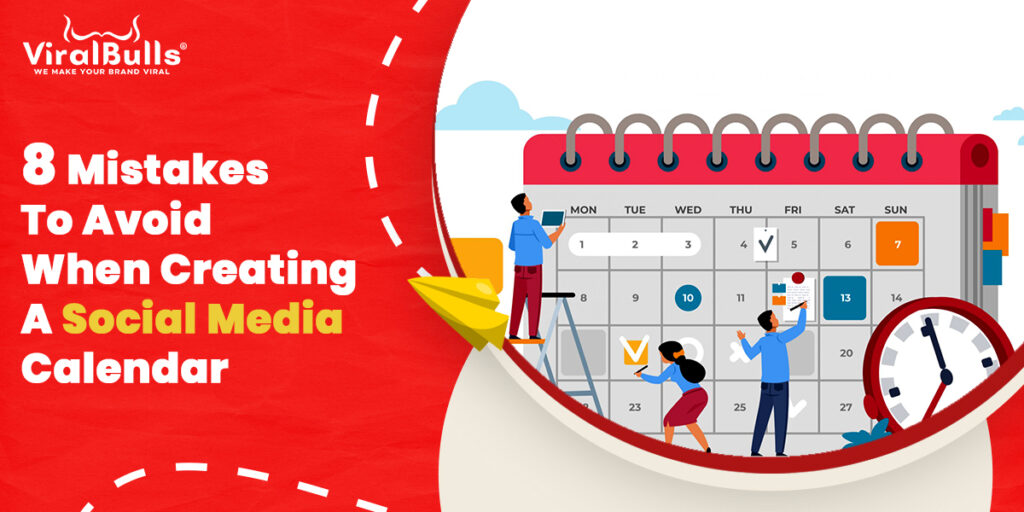Introduction
In today’s digital age, social media has become an integral part of any brand’s marketing strategy. Social media platforms like Facebook, Twitter, Instagram, and LinkedIn have billions of active users who can be targeted to reach a wider audience. However, creating an effective social media calendar is crucial to your success on social media.
A social media calendar is a schedule that outlines the content you will post on your social media platforms. It helps you plan your content in advance, so you have more time to focus on other aspects of your social media marketing strategy. Here are eight mistakes to avoid when creating a social media calendar:

Working on the social media calendar without goals and deadlines
Before you start creating your social media calendar, it’s important to set goals and deadlines. Your goals should align with your overall marketing strategy, and your deadlines should be realistic. Without clear goals and deadlines, you’ll have a difficult time creating content that resonates with your audience and drives engagement.
For example, suppose your goal is to increase your Instagram following by 20% in six months. In that case, your social media calendar should include content that encourages followers to engage with your brand, such as giveaways or user-generated content. You should also set deadlines for each piece of content so you can stay on track.
No sync between the creative and content
One of the biggest mistakes you can make when creating a social media calendar is not syncing the creative and content. Your content should be aligned with your brand’s values and messaging, and your creative should be visually appealing and on-brand.
For example, if your brand’s messaging is centered around sustainability, your social media calendar should include content that promotes eco-friendly products or initiatives. Your creative should also be aligned with your messaging, such as using earthy tones or natural imagery.
Not following the right template for the social media marketing calendar
There are many templates available for social media marketing calendars, but not all of them will work for your brand. Choosing a template that fits your brand’s needs and goals is important.
For example, if you’re a fashion brand, your social media calendar should include content that showcases your latest collections and trends. A template focusing on product launches and promotions would work best for your brand.
Not taking into consideration different social media platforms
Every social media platform has its unique audience, features, and content format. It’s important to consider these differences when creating your social media calendar.
For example, Instagram is a visual platform, so your content should be visually appealing and engaging. Twitter, on the other hand, is a text-heavy platform, so your content should be short, snappy, and to the point.
Not considering the different types of content formats in your calendar
Social media platforms offer a variety of content formats, such as images, videos, stories, and reels. It’s important to consider these formats when creating your social media calendar.
For example, if you’re promoting a new product, you could create an image post that showcases the product’s features and benefits. You could also create a video that shows the product in action or a reel that highlights the product’s unique selling points.
Lack of coordination within teams
Social media calendars often involve multiple teams, such as marketing, creative, and social media. It’s important to ensure that these teams are coordinated and working together to create a cohesive social media strategy.
For example, if your marketing team is promoting a new product launch, your creative team should create visual assets that align with the messaging and goals of the marketing team. Your social media team should then use these assets to create content for your social media platforms.
No provision for urgent edits and immediate posts
Social media is fast-paced, and sometimes urgent edits or immediate posts are necessary. It’s important to have a provision in your social media calendar for these types of situations. This could be a separate section of your calendar dedicated to urgent posts or a system for quickly creating and posting content.
For example, if there’s breaking news related to your industry, you may want to create a post to share your brand’s perspective or provide insights to your audience. Having a system in place to quickly create and post this content can help your brand stay relevant and top of mind.
Not segregating monthly and weekly calendars
Finally, it’s important to segregate your social media calendar into monthly and weekly calendars. This allows you to plan your content and ensure that your messaging is consistent across all platforms.
For example, your monthly calendar could include high-level themes and campaigns for the month, while your weekly calendar could include specific content for each platform, such as Instagram or Twitter. This approach ensures that you have a clear plan for your social media content and that you’re able to stay on track with your overall marketing strategy.
Conclusion
Creating an effective social media calendar is essential to the success of your brand on social media. By avoiding these common mistakes, you can ensure that your content is aligned with your goals, resonates with your audience, and helps you achieve your overall marketing objectives. With a well-planned social media calendar, you can take your social media strategy to the next level and drive real results for your brand.





